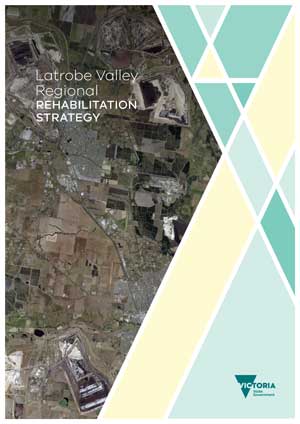Latrobe Valley Regional Rehabilitation Strategy
 The Latrobe Valley Regional Rehabilitation Strategy (LVRRS) outlines policy and provides guidance to progress mine rehabilitation planning.
The Latrobe Valley Regional Rehabilitation Strategy (LVRRS) outlines policy and provides guidance to progress mine rehabilitation planning.
The Latrobe Valley’s brown coal mines are inherently unstable, they are fire-prone and require a wide range of active controls to prevent harm to human life and the environment.
Hazelwood has ceased operations in 2017 and Yallourn and Loy Yang A have brought forward their power station closure dates. This means careful consideration and planning for mine rehabilitation needs to be undertaken now to ensure a positive legacy for the Latrobe Valley.
New regulations came into effect in 2022, requiring more detailed mine rehabilitation plans and more transparent decision-making with greater community engagement.
The LVRRS provides foundational policy, principles and actions to guide rehabilitation planning for the Latrobe Valley coal mines. The Strategy recognises that mine rehabilitation is complex and that it involves different risks and opportunities over many decades. It sets out a collaborative pathway for stakeholders to explore key issues with a clear view to ensuring the best possible outcomes for the region.
The LVRRS amendment, introduced in October 2023, helps to ensure the Latrobe Valley coal mines are transformed to be safe and stable for the long term.
A lot has changed since the LVRRS was released in 2020 including:
- the introduction of a strengthened regulatory framework for mine rehabilitation,
- the planned earlier closures of power stations at Yallourn and Loy Yang A, and
- the commencement of an Environment Effects Statement for the proposed Hazelwood Mine Rehabilitation Project.
The amendment takes account of the changes since 2020, and refines guidance based on new information gained through the implementation of the LVRRS to date.
The amendment provides the process for mine licensees’ rehabilitation planning and refines guidance on how water might be accessed for mine rehabilitation, if needed, in the future. The amendment sets out the type of conditions that could be applied to water access for mine rehabilitation, should a mine licensee make an application to use water as part of their mine rehabilitation plan. These measures will ensure water access for mine rehabilitation will not diminish the water entitlements of existing water users and values in Gippsland, and mitigate the potential future impacts of a drier climate.
The Strategy provides guidance to mine licensees, government, the community and other key stakeholders on issues that need to be considered in planning for and undertaking rehabilitation of the Latrobe Valley’s three brown coal mines.
Preparing and implementing mine rehabilitation plans is the responsibility of mine licensees. It needs to be underpinned by robust assessment and well-informed decision-making. The 2023 amendment to the strategy provides greater clarity to inform how the mine licensees develop rehabilitation plans.
The LVRRS enables government, industry and community to work together to ensure positive long-term outcomes for the Latrobe Valley.
The Gunaikurnai Traditional Owners, farmers, environmental groups, stakeholders and the community will continue to be engaged throughout mine rehabilitation planning. There will be further opportunities for community and other stakeholders to have their say as planning for mine rehabilitation continues, as set out in the LVRRS 2023 amendment.
The Mine Land Rehabilitation Authority (MLRA) is an independent authority working with community, industry and government. The MLRA facilitates the rehabilitation of declared mine sites to ensure they are safe, stable and sustainable for the beneficial use of future generations. Part of the Authority’s role is to monitor the implementation of the Strategy and provide assurance that government and industry is progressing mine rehabilitation planning.
Download the LVRRS 2023 amendment
Download the strategy
Page last updated: 31 Dec 2024